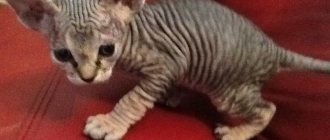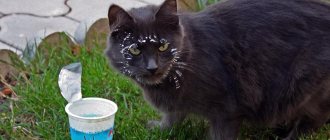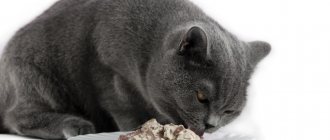Sphynxes are unusual cats that resemble aliens from another planet. Due to a genetic mutation and careful selection work, their body is completely or partially hairless. Because of this, representatives of the breed have a higher body temperature and require special conditions of detention.
Let's figure out how to care for the Sphynx in order to provide it with a comfortable and fulfilling life.
Preparing for the arrival of a kitten
In order for the process of weaning from its mother to take place without damage to the physical and psychological health of the little sphinx, it is taken to a new home no earlier than three months of age.
Representatives of this breed are usually reserved long before they are 12 weeks old. Therefore, happy owners have enough time to learn more about the features of caring for a kitten and prepare for its arrival.
To create decent living conditions for a hairless baby, they buy a “dowry” in advance:
- bowls for water, dry and wet food;
- carrying bag;
- tray with filler;
- scratching post;
- toys;
- grooming tools (nail clipper, toothbrush, etc.);
- hygiene products (ear cleaning lotion, toothpaste, etc.);
- bed or house.
In order to provide the little sphinx with not only proper care, but also safe living conditions, the apartment is also prepared for his arrival. Wires, indoor plants, household chemicals, fragile and small objects are hidden in advance from a curious and playful kitten.
On a note. When kept at home, inquisitive sphinxes try to explore every corner of their new property and often get into the most unexpected places like the oven or washing machine. To avoid tragedies, it is better to keep the doors of these devices closed, and before using the equipment, it is better to look inside once again to make sure that there is no little prankster in there.
Care devices
The Sphinx loves to sharpen her claws, so in order to protect furniture and other items from vandalism, it is recommended to purchase a scratching post. There are such types of it:
- Flat. Externally it looks like a rug. The item can be placed on the floor or attached to the wall. However, the product has drawbacks, the main one being its small width, which is why sometimes a cat may intentionally damage a wall or floor covering.
- Column. Comfortable design that is equally suitable for kittens and adults. It is recommended to buy a scratching post made from natural materials.
- House. A very convenient design that combines a scratching post and a house where the cat can hide.
Products have their own advantages and disadvantages. However, no matter what model the owner prefers, it is necessary first of all to give preference to scratching posts made from environmentally friendly materials. Some people prefer to make their own care devices. In this case, you can take into account all the preferences of your beloved pet and make him a design that will delight, amuse and bring double benefit.
Features of caring for the Sphinx
The exotic exterior cannot but affect the needs of the cat’s body. Therefore, it is better for potential owners to study in advance the features of care and maintenance of sphinxes.
Hairless cats have nuances with thermoregulation. Sphinxes do not tolerate dampness and drafts well. To protect representatives of the breed from hypothermia and colds, the room is maintained at a constant temperature within 20-25 °C. If this is not possible, the hairless cat is dressed up in a warm vest or blanket.
Sphynxes love warmth and love to bask in the sun. To prevent burns from leaving on the delicate skin, cats of this breed should not be exposed to ultraviolet rays for a long time.
Content Features
The first rule concerns the complete absence of hair. Although within any hairless breed there are flocked or brushed pets, most of them are absolutely hairless. Therefore, to prevent cats from freezing and catching a cold, the temperature in the room should be comfortable - not lower than 22-25 ° C.
Note: flock is a thin, rare fluff reminiscent of velor; brush (from English brush) - hard short wool with a crimped structure.
In addition, the apartment or house should be free of drafts and dampness (air humidity is within 30-60%). If it is impossible to maintain the necessary microclimate during the off-season, take care of additional insulation of the animal by putting on overalls and turning on the heater.
Important! Keep an eye out for radiators: the delicate skin of the sphinx can literally fry on hot heating pipes.
The second feature is the high sensitivity of the skin to ultraviolet rays. If an animal has been in the sun, for example, lounging on a windowsill on a clear day, then it will definitely sunbathe and may even get a serious burn. Among other things, the body color will change.
For example, there was a case when a pale blue sphinx, after a decent dose of solar irradiation, first became bright red, like that crayfish after boiling water, and only then coal-black. Fortunately, closer to winter, when solar activity began to decline, the skin cells were restored, and the cat again became a heavenly shade.
If a burning nuisance has occurred, then it is necessary to alleviate the suffering as much as possible:
- make a water compress, but the water should not be cold, so that the animal does not end up freezing and getting pneumonia; It is ideal to take water at room temperature;
- Do not use alcohol for a compress - it dries the skin too much;
- temporarily protect the animal from the sun's rays by closing the curtains or blinds;
- treat the affected areas of the body with anti-inflammatory and analgesic ointments: Panthenol, Bepanten, Saphroderm;
- introduce vitamin E into the diet, which promotes faster healing of inflammation;
- The same vitamin (sold in pharmacies in the form of capsules for oral administration) can be smeared on burnt areas.
Excess ultraviolet radiation is not only harmful to the skin, but also has a negative effect on the overall health of the cat: protein metabolism is disrupted, harmful radicals and carcinogens accumulate in the blood, the functioning of the endocrine glands changes for the worse, and sunstroke may occur. It is clear that life on earth is in principle impossible without the sun, but sunbathing should be moderate.
If your pet inexorably climbs onto the windowsill or is a big fan of walking in the fresh air, then a regular SPF cream for people will at least somehow prevent sunburn.
The right diet
In order for the Sphynx to develop well and remain healthy longer, it is provided not only with proper maintenance and care, but also with balanced feeding. To remain active and maintain body temperature, hairless cats require more high-calorie food than representatives of shaggy breeds.
On a note. If the Sphynx's diet is low in fat, the animal will become cold and begin to overeat to make up for the lack of energy. And this is fraught with digestive problems.
With the industrial type of feeding, high-calorie products of premium or super-premium class are purchased for sphinxes. Before making a choice, you need to carefully study the description of the composition and make sure that it has sufficient fat content and there are no questionable components.
The following criteria are met:
- Royal Canin;
- Acana;
- Grandorf.
With a natural diet, the Sphinx's menu is designed so that it contains at least 70% meat. Also included in the diet of cats of hairless breeds is:
- boiled offal;
- porridge with water;
- vegetables;
- eggs;
- dairy products;
- lean sea fish.
It is important to ensure that cats of this breed never eat bones, baked goods, sweets, smoked meats, pickles and sausages. Also, sphinxes should not be given mushrooms, onions, river fish, fresh milk and any leftovers from the master's table.
Feeding adult cats and kittens
Kittens' bodies grow until they are 10 months old, so they need nutritious food. Already from the first months of life, sphinxes are accustomed to solid food and given boiled veal. Pork is prohibited (by the way, as is lop ears), as it is fatty and can cause digestive problems.
At 4 months, small quantities of sea fish with the bones removed will be useful. From 6 weeks it is allowed to give yolk and cottage cheese. The owner himself chooses the number of feedings, but it is recommended to accustom the animal to a specific regimen.
The animal should have free access to food, they are not prone to overeating, but food helps them stay warm when freezing.
The basic rules for feeding Sphynx kittens, which they get used to and then eat like this for the rest of their lives, are:
- The menu must include meat. The daily norm is 30% of the body weight of a kitten or adult cat. Healthy protein is also present in fish and cottage cheese. You need 200 g per day.
- One third of your diet should consist of carbohydrates. These are a variety of porridges - buckwheat, rice, oatmeal. The Sphynx also needs fresh vegetables with the addition of 5 - 10 g of unrefined sunflower oil.
- In winter, portions for your pet should be larger.
- Sphynx cats have an accelerated metabolism, which requires a large amount of energy from food.
- You can also feed your animal with ready-made food - but not below premium class. This food must be selected specifically for this breed.
The health of the growing body will depend on the correctness of the diet.
Training and education
The affectionate and sociable nature of Sphynx cats, combined with high intelligence and good memory, make them ideal pets suitable for home keeping. A well-mannered cat will not damage furniture, ride on curtains or do other dirty tricks. Therefore, it is extremely important to have time to form the correct model of behavior in the kitten in the house.
On a note. You need to raise a Sphinx without using physical force. To stop unwanted actions or calm down an overly naughty kitten, you can lightly shout at it, splash water, or hiss threateningly.
Raising a Sphinx includes training in hygiene procedures. The kitten is taught to be calm about bathing, trimming nails, rubbing eyes, cleaning ears and teeth.
Toilet training
Even if the breeder’s kitten regularly went to the litter box, this does not mean that in the new home he will not recover anywhere. Therefore, to prevent the apartment from turning into a latrine for a cat, from the first moment the pet appears, you need to pay attention to its toilet training.
Typically, kittens defecate after sleeping or eating. Noticing that the baby is about to go to the toilet, he is carefully picked up under the stomach and taken to the tray. As soon as he does his job, he will definitely be praised.
On a note. If the kitten went to the toilet in the wrong place, the puddle is blotted with a napkin, which is then placed in the tray. And the “crime scene” itself is wiped with water flavored with a small amount of citrus juice.
Breed and its characteristics
Despite their unusual alien appearance, it is impossible not to admire Sphynx cats. This animal differs from its other relatives in that there is almost no fur on its body. That is why it is important to properly care for your pet’s skin and health, trying to create the most comfortable conditions for living and full development.
Both the adult and the small Sphynx are distinguished by their friendly, affectionate, flexible character. Cats love outdoor games and actively participate in everything their owners do. It is easy to raise and potty train a Sphynx, as the animal has a very developed intelligence. Animals never shit anywhere, they are clean and cannot stand a place where it is not cleaned.
The Animal Planet channel compiled a rating of the smartest varieties of cats, and sphinxes in this competition took first place of honor for their intelligence, quick wit, and strong love for their owner and his children.
Hygiene
To ensure that the Sphynx always has a neat and aesthetic appearance, he is provided with regular care, which includes a whole range of hygiene procedures.
Bathing kittens and adult cats
Despite the lack of hair, Sphynx cats need regular washing. Therefore, bathing procedures should become an integral part of caring for these animals.
Sphynxes are bathed once a month using baby gels or special shampoos for hairless breeds.
Important! Sphynx cats should not be dried with a hairdryer so that the hot air does not burn the skin. Therefore, after bathing, cats of this breed are dried with a towel and lubricated with baby cream.
Skin care
Sphynx cats have no hair, and their sebaceous glands produce a lot of secretion, which accumulates and turns into a brown crust. It not only makes cats look unsightly, but also causes discomfort. If left untreated, over time, the skin underneath begins to itch and emit an unpleasant odor. As a result, a cat of this breed develops inflammation and dermatitis.
Therefore, an important aspect of Sphynx care is regular cleansing of the skin. The body of a hairless cat is systematically wiped with special wipes or a moistened cloth, paying special attention to the folds.
Important! Improper or irregular care of the Sphynx leads to the formation of black spots on the cat's skin. The comedones are carefully squeezed out, and the affected area is treated with an antiseptic.
Eyes
Since Sphynx cats do not have eyelashes, they are prone to eye diseases. Grooming for the breed should include regular eye examinations.
In healthy cats, clear or brown discharge accumulates in the corners. Therefore, the eyes of the sphinx should be wiped daily with a cotton swab dipped in boiled water or chamomile decoction.
Important! If yellow or green discharge appears in the eyes, it is advisable to show the cat to a veterinarian.
Teeth
Caring for a Sphynx cat includes cleaning its fangs and incisors. This procedure is carried out at least 2-3 times a month using a non-foaming paste applied to a silicone brush or a special attachment.
Systematic care of your cat's teeth will help get rid of plaque, help strengthen the gums and serve as a preventive measure against the formation of stones.
Ears
Hair cats grow in their ears, which prevents the penetration of dust and dirt. Hairless Sphynxes have unprotected ears. Therefore, even with strictly residential care, caring for cats of this breed involves mandatory cleaning of the ear canal.
The ears of sphinxes are regularly wiped with a clean cloth soaked in a special lotion or Vaseline oil.
Claws
To ensure that a cat living at home does not damage furniture and walls, caring for it should include regular trimming of its claws. The procedure is carried out using a nail clipper very carefully so as not to injure living tissues or cause pain to the cat. If representatives of the breed do not have their claws shortened, then a considerable amount of money for repairs and renovation of furniture can be added to the cost of keeping the cat.
How to care for a Canadian kitten at home
It is recommended to purchase a Sphynx kitten at the age of 3 months.
The animal's insufficient age will create many problems. And by the age of 3 months, the baby is already toilet trained, eats on his own, and parting with the cat will not be painful for him.
The breeder must give recommendations on care and feeding rules. The new owner should maintain contact with the breeder in order to get professional advice if necessary and not seek rash advice from outsiders.
It is imperative to maintain the same nutrition by specifying the kitten’s habits and favorite foods. The same applies to the feeding regime. The main nuances of the establishment of Sphynx kittens are as follows:
- 6 meals a day until the age of 6 months;
- 3 feedings a day up to 9 months;
- after 9 months of feeding 2 – 3 times a day;
- mandatory training in bathing and other grooming procedures.
Important!
Caring for a Sphynx requires paying enough attention to its toilet.
A pet of this breed will never go into a dirty litter tray and will eventually choose another place in the house. It is useless to scold for this, since a dirty tray is the owner’s fault. The filler should not be allergenic. From the first days, the kitten needs to be shown the place of the tray, so that later he knows and understands it.
Vaccination
Sphynxes kept at home run the risk of becoming victims of viral and infectious diseases no less than their street counterparts. To protect cats of this breed from dangerous diseases, their care should include routine vaccination.
They are regularly vaccinated with a complex drug that stimulates the development of immunity to panleukopenia, calcivirosis and rhinotracheitis.
This is done for the first time when the kitten is 7-8 weeks old. After 4 weeks, the sphinx is revaccinated against the same diseases and against rabies. In the future, the cat is vaccinated annually, regardless of whether it is exclusively kept in an apartment or is on the street.
Important! Before vaccination, the animal must be subjected to antiparasitic treatment. Anthelmintic drugs are given to the cat 2 times with an interval of 10-14 days. The dose is calculated based on the pet's weight.
How to teach calm bathing?
Sphynx owners advise giving a treat after each water procedure, then bathing will no longer be a big stress for the animal. The greatest reward is given if the animal behaves calmly.
To teach your Sphynx to bathe, you need to adhere to the following recommendations:
For bathing, it is recommended to collect water without the presence of an animal and its volume should not be large.
- You should not fill a basin or bathtub full. To wash the animal, it is enough to pour liquid up to the ankles.
- Filling a basin or bathtub should be done without your pet, otherwise he will be scared by the roar of water ahead of time.
- Immediately after traveling or relocating an animal to a new home, it is better to postpone water procedures. It takes time for the sphinx to calm down and get used to the situation.
- Feeding before bathing is prohibited, because this will negatively affect physical well-being and can lead to gastrointestinal upset and vomiting.
- If your cat has an acute negative reaction to bathing, you can hide the water by whipping up a fluffy layer of foam.
- Vaccination is a contraindication to water procedures. You should pause for 14 days.
- If it is cold in your home, then swimming is strictly prohibited. In warm weather, it is also necessary to close windows and doors to avoid drafts.
- The sphinx's negative attitude towards water procedures may be associated with further hypothermia, so the pet must be wrapped in a towel and covered with a blanket.
- Washing two animals at the same time is a bad idea, which will not allow the owner to control the process and will increase stress.
Health and treatment
The Sphynx is a cat with a high body temperature and a rapid heartbeat. Due to the complete or partial absence of hair, representatives of the breed have a number of health problems.
Hairless cats are often diagnosed with:
- obesity;
- dermatitis;
- acne;
- digestive problems;
- ophthalmological diseases;
- pathologies of the caudal spine.
Since any disease is easier to prevent than to treat, a set of measures for the maintenance and care of the St. Petersburg, Canadian or Don Sphynx should include preventive veterinary examinations.
Important! When the first signs of illness are detected, the cat must be taken to a specialist.
Sphynxes are special cats, the maintenance of which requires knowledge of a number of important nuances. Therefore, potential owners should clearly understand that those with an affectionate character and exotic appearance will become excellent companions only for those who are ready to properly care for them.
How to wash a Sphynx
The choice of shampoo for bathing your Sphynx is important. It is preferable to use a detergent specifically for hairless cats, preferably based on natural ingredients. There are few of these on the market. Therefore, you can choose a shampoo for Sphynx cats labeled “moisturizing” or “relieving irritation” or “to control dandruff.” As a rule, these are shampoos with herbal decoctions, the addition of aloe, and oatmeal.
If it is not possible to buy a specialized shampoo for hairless cats, it is permissible to use products for newborns with a pH level of 5.5. Other children's shampoos are not recommended for use.
You cannot take shampoos that say “super cleansing”, “texturizer”, or containing oil or lanolin. Shampoos with super-cleaning are needed only in one case - if the cat, and this often happens in young and uncastrated cats, has a strong secretion of sebum at the base of the tail. In such cases, acne and comedones often form in this area. It is to combat the “pimply tail” that super cleaning is needed. Keratolytic shampoos containing lactic acid are also shown. Such products reduce sebum production and, accordingly, relieve skin inflammation.
Description of breed standards
If a cat's body is not covered with hair, this does not mean that he is a representative of the Canadian Sphynx. Even the smallest deviation from official standards turns the animal into an ordinary hairless cat. Features of the appearance of the Canadian Sphynxes are as follows:
- The size of the pet is small. As a rule, they weigh no more than 6 kg. Females are somewhat smaller than males. Their weight is about 4 kg.
- Animals are distinguished by a muscular and strong physique, but at the same time they have soft and smooth body contours. They captivate with their grace and elegance. Sphynxes have a round belly that resembles a ball.
- The chest is quite wide, which is why the pet’s paws are always widely spaced. The limbs are medium in size, thin and strong with long fingers, on which sparse fluff may remain. The hind legs are longer than the front legs, which makes the gait special.
- The head is wedge-shaped, medium in size, with prominent cheekbones.
- The bridge of the nose is wide, the nose is small, slightly covered with short hair.
- The ears are set far apart and may droop. They are large with a wide base and rounded ends without brushes.
- The eyes are large, deep and very expressive, shaped like a lemon. Color may vary. Usually it harmonizes with the color of the animal, but most often the bright green shade predominates.
- The tail is long, sometimes with a tassel at the end. Animals most often roll it up and press it to their body.
- Mustaches are practically absent, but their presence is allowed.
- The nose, the area behind the ears and the tip of the tail are the only places that may be covered with short hair or fluff. Canadians' skin is quite soft and velvety.
- The color can be absolutely anything: monochromatic or in various combinations. Black, purple, silver, white and other shades are allowed. Due to their susceptibility to pigmentation, tri-colored individuals are often found.
One of the peculiar features of Sphynx cats is that they have interesting folds that do not straighten out even if the cat is pulled out to its full length. The presence of folds on the forehead, neck and limbs is considered mandatory.
Frequency of bathing and duration of water procedures
The following factors have a significant influence on how often your Sphynx should be washed:
- conditions of detention;
- nature of the diet;
- health status;
- individual characteristics.
The Sphinx should be bathed as often as required by basic hygiene rules. When your cat’s skin becomes sticky, oily and has an unpleasant odor, don’t hesitate. It’s time to give him a bath. The interval between water procedures should ideally be at least two and no more than 4-5 weeks.
Bathing more often than once every 12-14 days is not recommended for the Sphynx cat breed. There is a risk of completely washing away the required minimum protective fat layer. Failure to comply with this rule will lead to the development of skin irritation or dermatitis in the animal.
If there is a need for more frequent bathing, it is recommended to use special wet wipes for sphinx hygiene. When wiping a cat with this product, sweat and fat secretions dissolve and are removed from the surface of the skin.
The wipes have disinfectant and deodorizing properties and have a calming effect on delicate skin. You can buy them at a veterinary pharmacy.
Particularly contaminated areas of the skin are wiped with a clean soft cloth, which is moistened in warm water.
If your cat is sick or has recently been vaccinated, bathing should be postponed until she is fully recovered. Also, kittens are not washed until they reach 30 days of age.
Important! The Sphynx cat must be washed after recovering from an illness or after completing antiparasitic measures. Water and shampoo will remove toxins released in sweat.
Cats of almost all breeds do not like to bathe. Sphinxes are no exception: they experience severe stress during water procedures. Therefore, manipulation time should be reduced as much as possible. Experienced breeders recommend bathing the Sphynx in 5-10 minutes, confidently, quickly and carefully.











